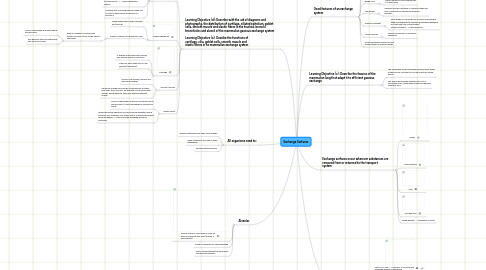
1. Alveolar
1.1. Alveolar tissue is composed of many air spaces divided by thin walls (around 5 micrometres)
1.2. Close to capillaries for rapid exchange
1.3. elastic fibres between the walls gives strength and flexibility
2. All organisms need to:
2.1. Absorb substances from their surroundings
2.2. Make substances as a part of their metabolism
2.3. Remove waste products
3. Learning Objective (d): Describe with the aid of diagrams and photographs, the distribution of cartilage, ciliated epitelium, goblet cells, smooth muscle and elastic fibres in the trachea, bronchi, bronchioles and alveoli of the mammalian gaseous exchange system Learning Objective (e): Descibe the functions of cartilage, cilia, goblet cells, smooth muscle and elastic fibres in he mammalian exchange system
3.1. Goblet Cells
3.1.1. Secrete mucins - which dissolves in water to produce mucus
3.1.2. unregulated and continuous secretion
3.1.3. Mucus is removed by cilia in a 'wave' like motion
3.1.4. Found in the lining of the respiratory tacts
3.1.5. found scattered among other cells
3.1.6. In tissue cells such as the colon, they're much more common
3.1.6.1. When you pass the faeces, it makes it easier and smooth
3.1.7. 'Goblet' Stores mucus which is then released to trap bacteria <-- Mainly respiratory system
3.1.8. Contains lot's of mitochondria to make ATP in order to have energy to perform it's functions
3.2. Ciliated Epethilium
3.2.1. found within inner lining of trachea and bronchi
3.2.2. made of ciliated cells which have cilia
3.2.2.1. beat in a rhythmic synchronised pattern to move mucus to the back of the throat
3.2.2.1.1. Mucus is swallowed and destroyed in stomach acid.
3.2.2.1.2. Also destroys the microorganisms that the mucus traps
3.3. Cartilage
3.3.1. C shaped rings around the trachea, and irregular blocks in bronchus
3.3.2. Keeps air ways open even in low pressure (inhalation)
3.4. Smooth Muscles
3.4.1. Found in the trachea, bronchi and terminal bronchiles
3.4.2. Fibres are arranged around the circumference of tubes that when they contract, the diameter of the lumen gets smaller. During exercise, they relax and this improves airflow
3.5. Elastic Fibres
3.5.1. Found in the trachea, bronchi, bronchioles and in alveolar walls. It is also embedded in connective tissue.
3.5.2. Stretched during inhalation and recoil during exhalation which forces air out. Important as it allows alveoli to expand according to the air inhaled => Max SA for gas exchange. Prevents overfilling.
4. Surface Area:Volume
4.1. Small SA:V ratio --> Diffusion is too slow and exchange surface is specialised
4.2. Learning Objective (a): Explain, in terms of surface area:volume ratio, why multicellular organisms need specialised exchange surfaces and singly-celled organisms do not.
4.3. Single celled organisms and small organisms can exchange substances across their outer surfaces because they have a large SA:Volume ratio
4.4. As multicellular organisms get bigger, the distance from the exchange surface gets bigger and the SA:Volume ratio decreases.
4.5. The large number of cells in a multicellular organisms means that more nutrients are required and so the outer surface is not big enough to allow gases/nutrients to diffuse fast enough to keep all of the cells alive This meant that specialised exchange systems are developed.
5. Exchange surfaces occur wherever substances are removed from or returned to the transport system
5.1. alveoli
5.2. small intestine
5.3. liver
5.4. root hair cells
5.5. fungal hyphae --> equivalent of roots
6. Good features of an exchange system
6.1. Learning Objective (b): Describe the features of an efficient exchange surface, with reference to diffusion of oxygen and carbon dioxide across an alveolus.
6.2. Large surface area
6.2.1. Provides more space for molecules
6.3. Bigger SA:V
6.3.1. Faster diffusion & more substances in a given time
6.4. Thin Barrier
6.4.1. Reduces diffusion distance so diffusion takes less time. Important for maintaining diffusion gradient.
6.5. Diffusion Gradient
6.5.1. Fresh supply of molecules on one side of membrane (high concentration) & removal of required substances on other side (low concentration) Steeper Gradient --> faster diffusion
6.6. Moist Surfaces
6.6.1. Speeds up diffusion in terrestrial organisms
